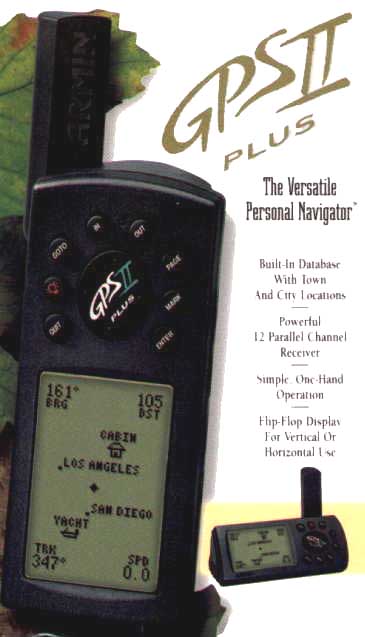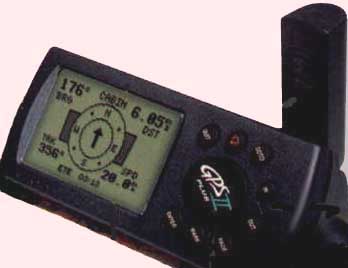
A GPS (Global Positioning System) receiver and
EW
Flight Recorder are installed. The GPS is the up-to-date
Garmin model
II Plus, mounted horizontally on top of the instrument console for 'head-up' safety. This is connected to the latest EW Model D Flight Recorder, a digital electronic barograph which records flight track and altitude. Flight data can be downloaded after landing, and flight traces displayed and analysed using
FlightMap, a proprietary program designed and marketed by IGC member David Eade.

Horizontal format for 'head-up safety
Flying with GPS is now compulsory in competitions. It is also a considerable safety aid when flying in wave at high altitude. The weather can deteriorate, causing cloud gaps to close quickly. If this happens, GPS enables the pilot to descend in a safe area. However, there is a drawback with some GPS receivers if they are not mounted sensibly, leading to too much 'head down' and poor lookout by the pilot. The BGA recommends a 'head-up' configuration, which is why we have chosen the Garmin GPS II plus.
The excellent Dittel 720-channel radio allows the pilot to contact airfield and airspace controllers, and to keep in touch with other gliders. 177 is kept in its trailer but can be rigged in about fifteen minutes, requiring just one helper to support the wing tips. It can be towed out to the launch point single-handed, as a complete set of towing-out aids is available. In good weather, water ballast may be carried, to improve high speed cruising between thermals.
Renovating 'Delta Golf Kilo' to Betty Blue
In her 30th Birthday year, the IBM Gliding Club's wooden glider 'DGK' flew in her smart new livery. Renamed Betty Blue, the K6-CR made her maiden flight at Lasham airfield in the spring of 1997. This followed a major refurbishment project (which some thought might never be finished) watched with interest by many of the 600 members of Lasham Gliding Society.
In October 1993 a decision was taken to 'freshen up' what was becoming an increasingly shabby, aged glider. With an expectation that the work would be completed by the following spring no-one considered it such a major step. A further decision was made, however, to totally renovate the glider. The result (18 months later) was a superb example of a classic glider, worth possibly twice the asking price in 1993.
The 'FiFi' project team (Fix it, Fly it!) comprised a stalwart band of members; Malcom Laing (then IGC secretary), Beth Hutchison and husband John Hartley, John Dunman, Ian Wheway (then IGC treasurer) and club chairman Nichol Riggott. The team were guided by an experienced glider engineer from Lasham, Gordon McDonald. In addition, a number of other members, and even non-members, gave considerable and much-appreciated help; notably Mike Evans, Nigel Spooner and son, Frank Effenberg, David Henry and Mike Rumsey. Betty even got a new set of wing covers, hand made for her by the mum of former IGC member Alan Jacobs.
FiFi work was carried out during evenings and weekends, and total effort was estimated at around 600 hours. This saved the club about £12,000. The final, highly skilled, finishing was done by the local professionals, Southdown Aero Services, the firm who recently built a replica of the Colditz glider.
Betty is flown by IGC pilots who have completed the required number of solo flights. This stage can be reached in a few months, so for pilots starting their training in the spring, for example, they could be experiencing the thrill of solo flying during late summer.